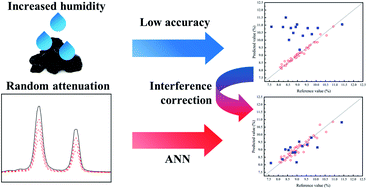Correction of moisture interference in laser-induced breakdown spectroscopy detection of coal by combining neural networks and random spectral attenuation†
Abstract
Moisture is a critical factor that interferes with laser-induced breakdown spectroscopy (LIBS) spectra and reduces the analysis accuracy. The correlations between LIBS intensities of coal and moisture content were studied in some work, but the results were not applied to the correction of spectra. Regression models of volatile content were established based on low humidity samples to analyze samples with higher moisture content in this study. The random spectral attenuation method was proposed to reduce moisture content disturbance. The calibration spectra were replicated and multiplied by random attenuation coefficients to introduce information about the possible interference. All of the simulated attenuated spectra were used to train the artificial neural network (ANN) quantitative model. Compared with direct modeling without random spectral attenuation, the coefficient of determination (R2) was improved from −3.4291 to 0.7102, and the root-mean-square error (RMSE) was reduced from 1.8709% to 0.4786% in the analysis of volatile matter content interfered by moisture. The results showed sufficient ability of the method to detect samples disturbed by moisture without additional sample pretreatment and improve the speed of LIBS analysis.

- This article is part of the themed collection: JAAS HOT Articles 2022


 Please wait while we load your content...
Please wait while we load your content...